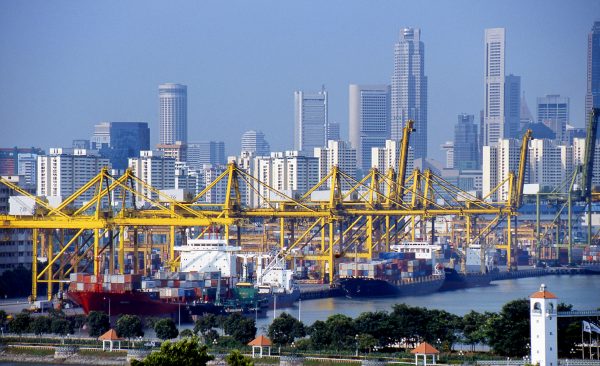As per the original plan, the Hanimaadhoo airport in the Maldives should open this year. From the international perspective, the important aspect is that the infrastructure is coming up thanks to a loan offered by India in a country where New Delhi’s influence continues to clash with that of Beijing. But there is more to this factor – while the credit was sourced from a public Indian institution, Exim Bank, the company that is undertaking the project, JMC Projects, is a private firm from India.
In Sri Lanka, another small island nation in South Asia where New Delhi and Beijing are competing for influence, the West Container Terminal is being developed by the Adani Group. The group is one of the largest private Indian companies and an ally, so to speak, of the Bharatiya Janata Party (BJP) government in New Delhi.
These two examples are part of a bigger trend; Indian private companies are playing an increasingly large role in New Delhi’s foreign policy. Another firm, GMR Group, is the only Indian company to manage airports outside Indian territories, in the Philippines and Indonesia; it is also taking part in developing an airport in Greece. These states cannot be considered the most important from the perspective of the Indian government’s foreign policy, and thus such undertakings most probably represent the company’s own initiatives – in the sense of picking an objective solely for profit, not to partially assist the government in achieving its political goals.
There are, however, recent cases of Indian firms stepping in where New Delhi needed them to (not necessarily where they would choose go on their own). Indian private companies were involved, among others, in projects in Afghanistan and were to do so also in Iran (as part of the Chabahar project). In both cases, the projects failed to yield concrete, long-term profits for India due to external factors – the Taliban takeover in Afghanistan and U.S. sanctions on Iran – but had this not happened, private capital would have given New Delhi more elbow room in both countries.
Two more recent instances are much better known and can be counted as successes from New Delhi’s perspective (not necessarily from the perspective of the West). A private Indian company, Serum Institute of India, became the largest manufacturer of AstraZeneca’s vaccines during the COVID-19 pandemic. One of the country’s largest conglomerates, Reliance, is currently processing a majority of Russian petroleum crude imported to India. In both cases, these firms could do so partially thanks to their massive manufacturing and processing capacities and cheaper costs of doing so in India.
Moreover, in both cases, the role these companies played was crucial for New Delhi’s foreign policy goals. The first was the largest element of India’s vaccine diplomacy; the second allowed New Delhi to strengthen relations with Russia when Moscow was being criticized and sanctioned by the entire West for its invasion of Ukraine (and this is why I stress the latter was a success from New Delhi’s perspective).
The two major benefits that large Indian companies offer to the New Delhi government are, rather obviously, capital and technological know-how. It is clear that the direction the Indian government is taking is to outsource even more strategic initiatives to large domestic companies. This is a significant departure from past decades where undertakings such as developing military products were mostly awarded to public firms.
For instance, New Delhi’s current defense policy assumes that the most important strategic military platforms, such as advanced aircraft, will be built for India by private foreign companies but in cooperation with domestic private companies. The assumption is that a private Indian company will not only be financially and organizationally prepared to handle such a massive project but will also handle the technology transfer better than the government. 5G networks are being introduced in India following a similar model – after public bids where the government has the final say, but undertaken by partnerships of private foreign companies and private domestic companies. The Indian Ministry of Defense is currently inviting domestic private companies to participate in bids to develop semiconductors for the government.
Until the 1980s, India was much more of a socialist economy. The reforms partially commenced in that decade, but mostly in the 1990s, have led to a large-scale opening of the private market, thus making large Indian firms even stronger than before.
Apart from the aforementioned factors that make large Indian companies increasingly important for New Delhi (capital, organization, know-how, and of course, being Indian), it must be pointed out that these firms are also likely exerting more influence on the government than in the past. A particularly controversial political topic in today’s India involves electoral bonds – the current Modi government made it very hard to establish which entity or individual is funding which political party. However, certain general factors are telling – the ruling party, the BJP, is receiving more funds than all other parties combined. At the same time, its government is clearly favoring certain companies, such as the Adani Group, in the way it awards bids and projects. It is assumed, even though it cannot be currently proved, that such firms are the largest donors to the ruling party (and most likely to other leading parties, including the opposition ones, to hedge their bets).
With this process deepening, it is sometimes hard to tell whether a given project was at first a government undertaking outsourced to a private company, or whether the original initiative came from the corporate side. For instance, when it comes to imports of Russian crude, New Delhi has faced both political risks (in relations with the West) and political gains (in relations with Moscow), while the primary economic gain is to the company, Reliance. The company processes petroleum crude into oils, and so its natural objective is to buy crude as cheaply as it can and sell at as high of prices as customers will bear. Thus, Reliance is currently benefiting from a comparatively lower price of the Russian crude – while it is New Delhi that is forced to explain these imports to the Western governments and audiences. However, this naturally means that Reliance will cease to import Russian oil the moment Rosneft stops offering a discount to Indian companies – and this will happen even if, from the political perspective of the New Delhi government, retaining imports from Russia is still politically desirable.
When it comes to Serum Institute of India, in turn, its success seemed to have been entirely of its own making. It was due to the Serum Institute of India’s unmatched manufacturing capacity, but also probably as a result of a recent Serum Institute of India investment in AstraZeneca, that the European company chose the Indian one as its partner. It was only as a result of this that New Delhi could cash on this success with a large part of its vaccine diplomacy.
Thus, when it comes to cooperation and the power balance between the New Delhi government and large private firms, India is very gradually going the U.S. way. India is a much smaller and less advanced economy and state than the United States. However, even while taking note of this disproportion, two general similarities stand out between what the U.S. has long been doing and what India has recently started to do. First, the New Delhi government, just like the one in Washington, is open to outsourcing even projects of strategic and clearly military value to private companies. Second, the corporate sector appears to be a huge donor to leading Indian parties, thus arguably exerting a degree of influence on them, to a point when national interests are partially merging with the interests of the largest concerns.





















Discussion about this post